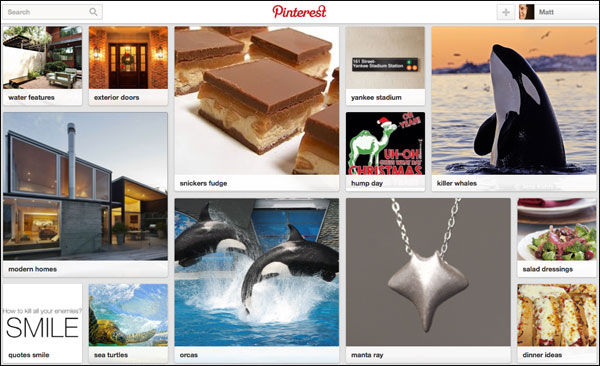How To Market On Pinterest And Instagram — Even If You Don’t Have A Branded Account
- Fahad H

- Feb 4, 2014
- 4 min read
Looking for ways to boost your organization’s social media engagement in 2014? As a marketer, you’re tasked with the slippery job of putting together content strategies in an environment that’s constantly changing, thanks to social media’s seemingly infinite capacity for rolling out new channels and products.
Who could blame you for focusing on the one or two networks where your brand already has a presence?

Companies that don’t yet have profiles on Pinterest or Instagram tend to overlook these platforms when it comes to planning their marketing campaigns. After all, most social programs are designed with the goal of creating new fans and followers. On the surface, it doesn’t seem to make sense to invest the time and money in a network where there’s no official account to promote.
The truth is, increasing a brand’s fan base via social media is just one benefit of many. Pinterest and Instagram are ideal for visual brands related to food, beauty, lifestyle, media and fashion — but both networks are still in their infancy in terms of being embraced by marketers. Those that aren’t expanding beyond the reach of Facebook and Twitter are missing out on some amazing opportunities.
Visual Networks Have Valuable Demographics
It’s becoming clear that Pinterest and Instagram are incredibly effective for reaching women (84% of Pinterest users are women) and younger audiences (over 90% of Instagram users are under 35). Additionally:
Pinterest is now used by more than 1 in 5 U.S. adults (21%), as well as a full third of U.S. women.
From September 2012 to September 2013, Pinterest drove more referral traffic to publishers than Twitter, Reddit and LinkedIn combined.
The average Pinterest user has a household income of over $100,000.
Instagram’s user base “is largely made up of young, urban demographics, with a significant skew towards women.”
Over 1 in 5 teens (ages 13-18) use Instagram regularly.
We all know what it can take for a brand to add a new social media profile: layers of legal and red tape and bureaucracy. The average young consumer isn’t waiting for companies to figure it out, though. She likely has multiple accounts that she creates on the fly, and she loves following brands, sharing brand imagery and commenting. Marketers can still connect with her, even without an official account presence.
Shared Content Drives Initial Exposure
Conversion rates for Pinterest traffic have been reported to be as much as 50% higher than conversion rates from other traffic sources — and Pinterest is the clear winner as compared to Facebook and Twitter in introducing customers to retailers. Instead of simply reinforcing brand loyalty, this is a social network that’s leading the pack in terms of first-touch marketing.
Visual social media can send traffic directly to a brand site, or to blog posts that talk about your brand. Is it truly possible to get measurable results outside the default goal of increasing social media followers? Here are just three tactics for doing so:
Recipes. This Pinterest board for Kikkoman (disclosure: Kikkoman is a Sway Group client) featured original recipes created by Latina bloggers using Kikkoman products, and generated hundreds of followers who in turn repinned branded content.
Printables. “Printables” have become wildly popular on Pinterest, and the benefit for marketers is clear: create value with a free graphic product, and your logo and brand message will spread organically. Almost anything can be turned into a printable: party signs and supplies for a food brand, family crafts for a parenting-focused service, makeup how-tos for a beauty product … the sky’s the limit.
#Hashtags. Hashtags on Instagram and Pinterest give followers an easy way to participate in a brand’s activities. Use a hashtag to promote a new product or service, and you not only extend the reach of your owned content, you create an opportunity to begin crowdsourcing user-generated content. In particular, the Instagram community relies on hashtags not only to discover new content, but to share it as well.
Metrics Change Minds
When you think of what defines a successful marketing program, end goals come to mind. Consider KPIs like click-throughs, new customers, new demographics, boosted traffic numbers — and ultimately, increased profits.
However, it’s also true that nothing influences a conservative team like numbers. The easiest way to convince management that it’s time to set up a profile on a new social platform is with the hard data a campaign produces: impressions, pins, repins, likes, comments.
For businesses that are starting to experiment with their marketing performance across various channels, turning to an agency that specializes in social media can save time and make the process more efficient. Agencies have experience across numerous industries, they know which networks are most beneficial for different demographics, and ideally, they know how to execute campaigns that get targeted results.
Most importantly, they know how to measure. Skilled agencies leverage analytical software like HootSuite, SproutSocial, Google Analytics, or in-home proprietary systems that not only optimize campaigns, they pull in the data that’s needed to determine ROI.
It’s All About The Big Picture
The bottom line is that in today’s world, it’s not always enough to focus on one social media platform. With Pinterest rapidly becoming the go-to choice for moms sharing content, and Instagram continuing to gain traction among younger demographics, marketers can’t afford to ignore the rich possibilities these networks offer.
At the end of the day, a business’s presence (or lack thereof) on a specific network is actually far less important than the network’s overall potential. Because a social campaign isn’t just about creating more followers — it’s about starting a brand conversation that resonates with the intended audience.
Image via Flickr/bunchesandbits








Comments